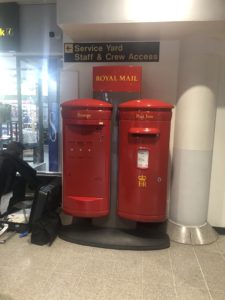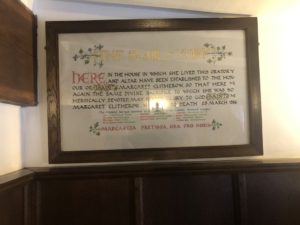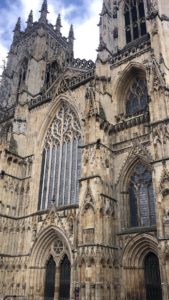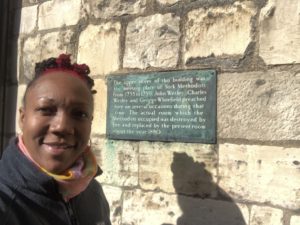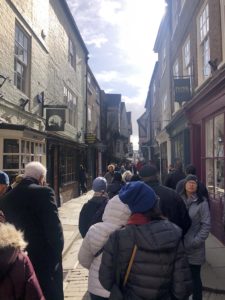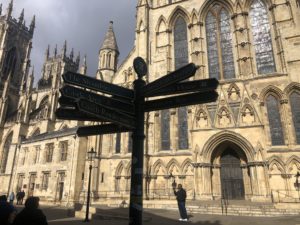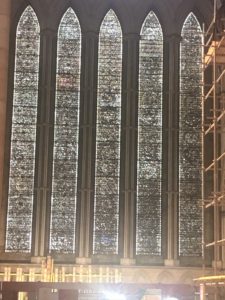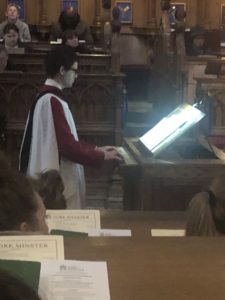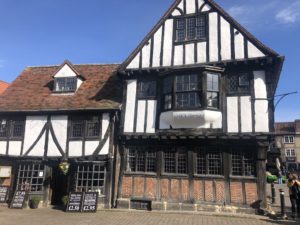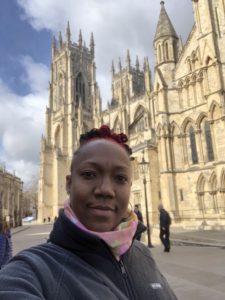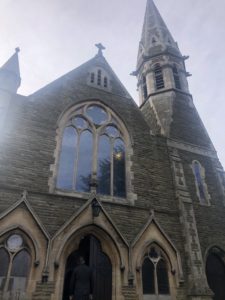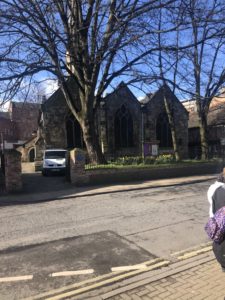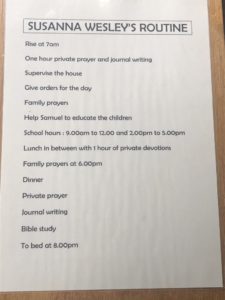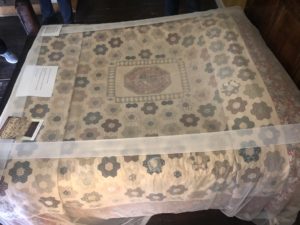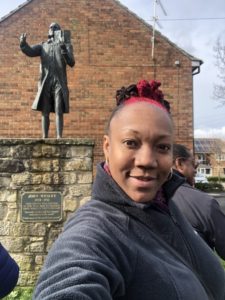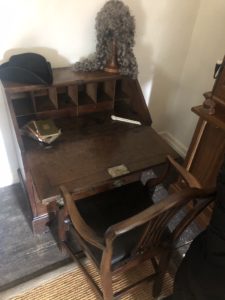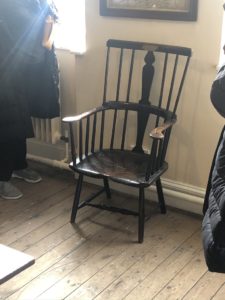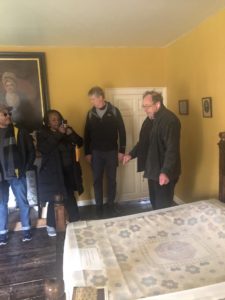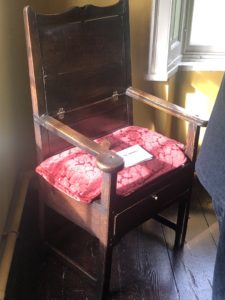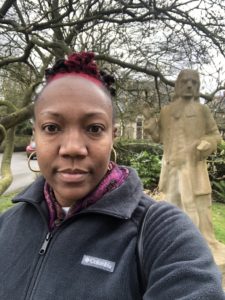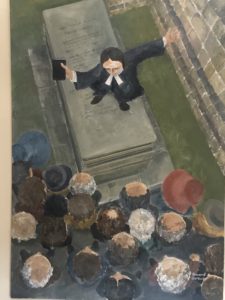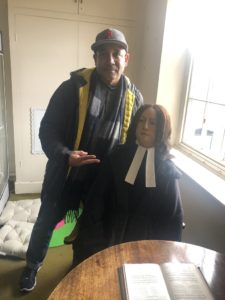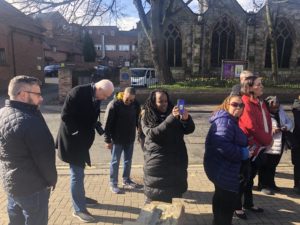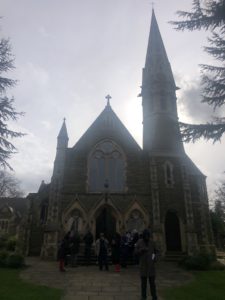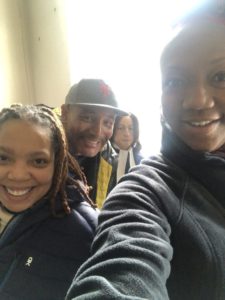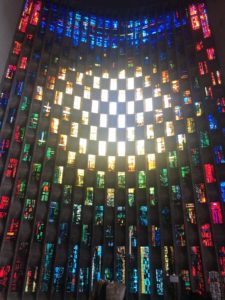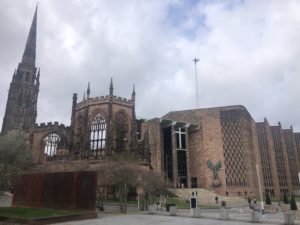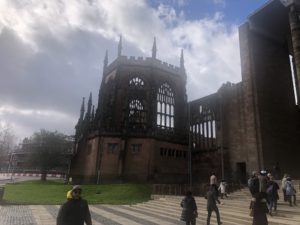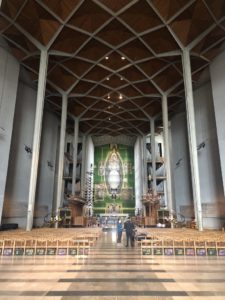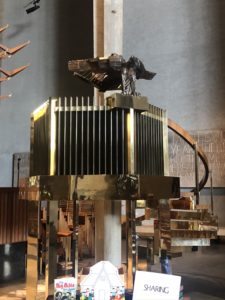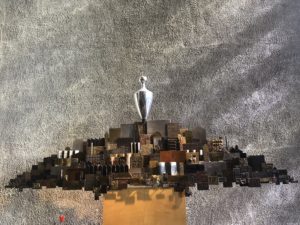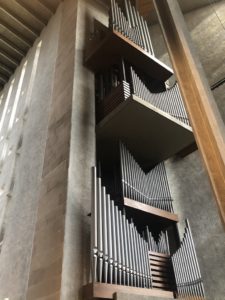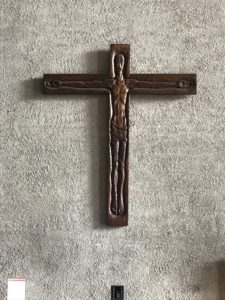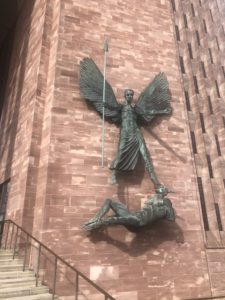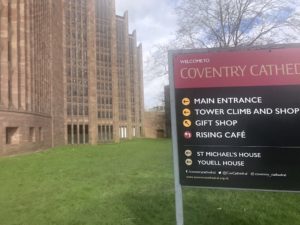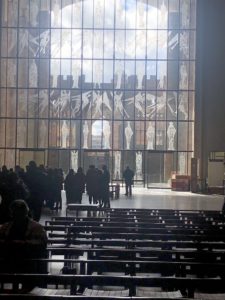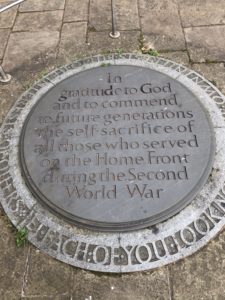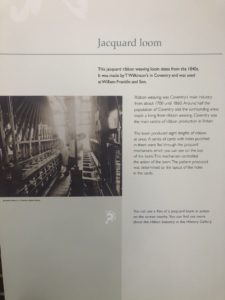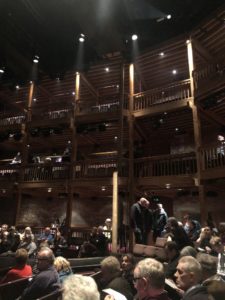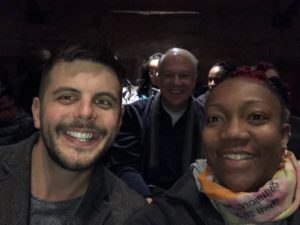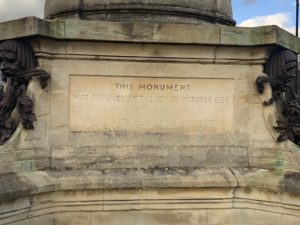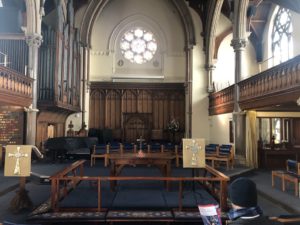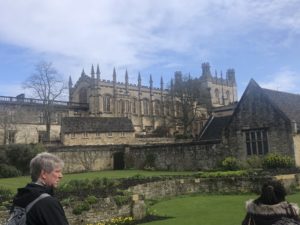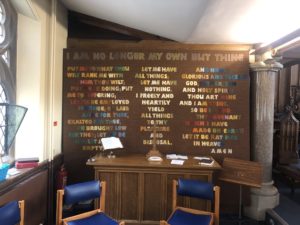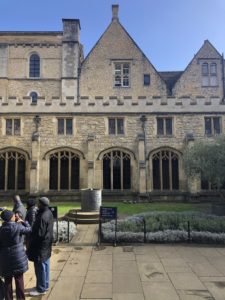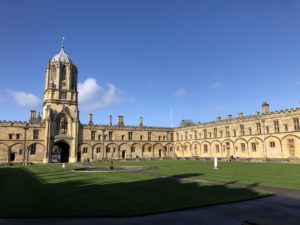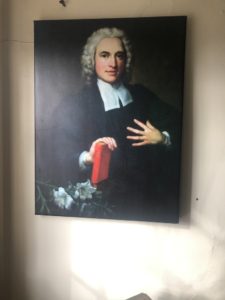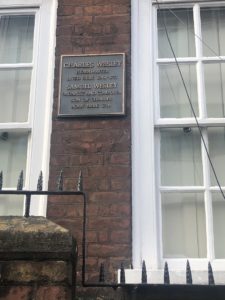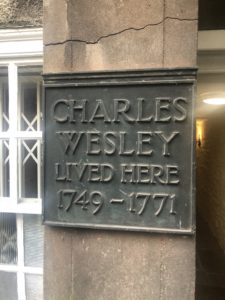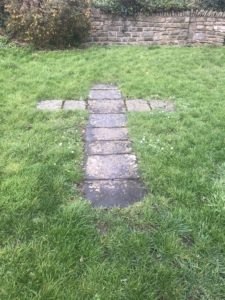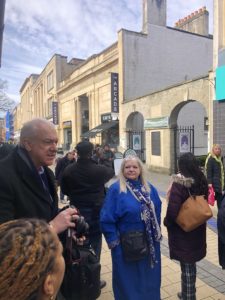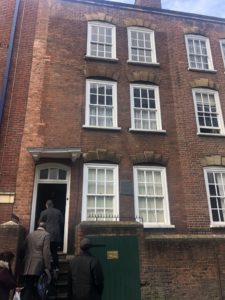By Rev. Elizabeth C. Abel

Bishop Thomas J. Bickerton treated new ordinands to a Wesley Heritage Tour in the United Kingdom. This trip offered newly affirmed ordinands an opportunity to go to the roots and foundation of Methodism by experiencing John and Charles Wesley firsthand.
Orientation happened three weeks prior to departure with an English tea. We were blessed to have select Conference staff join the tour as an opportunity to meet the new ordinands. This was true for Bishop Bickerton as well. This space away from home lent itself to free conversation about our call and our vision over food, fun, and new experiences and adventures.
Each ordinand was assigned a day for devotion and an opportunity to journal daily in a collective journal that would be turned into the conference for a collective voice of the journey. The different perspectives provided a wide range of views, thoughts and laughter.
Rev. Abel was assigned the first day for devotion that was to be shared upon arrival in Manchester.
Days 1 & 2: Depart from USA
On the day of departure, 22 of us gathered at the Conference Center in White Plains just after Sunday Worship, with a 2:30 p.m. show time for the Bishop,
new ordinands, Conference staff, spouses and a few Conference clergy willing to brave the company for this experience, and one of our finest lay persons who is a John Wesley scholar. We gathered to begin our journey to Philadelphia International Airport from where we
would be departing. (A much better starting place than JFK International – a cheaper flight and easier check-in through TSA.) We were scheduled for an overnight flight departing at 9:30 p.m. Once through security, we had dinner in the airport, and prepared for sleep. Upon boarding, we found ourselves wiping down our areas with Lysol wipes and Purell hand sanitizer, for COVID-19 – the novel coronavirus — had already introduced itself to the world.
Bishop Bickerton encouraged us to sleep and
some of us were able to, but many took advantage of watching movies and enjoying the space away from our normal day-to-day. Seven and a half hours and a new time zone later, we landed in Manchester, UK, where we were greeted by our tour guide Jan, and Rolli, the coach driver (otherwise known as a bus, but in the UK, buses are for public transportation, and coaches are for private transport). Another 1.5 hours to York. Thank goodness no one asked for the devotional because as soon as we boarded the coach, I was asleep!
Once in York, we checked in to our hotel, and went on a quick walking tour of York, which included the Medieval Castle of Yorkshire, built by King Edward II, Yo
rk Minister Cathedral, the Market Square, Marks & Spencer department store, which is known to have the best exchange rate, and an afternoon of rest before dinner at 6:00 p.m..
After dinner, we gathered for conversation, where I was able share my devotional for the evening, from Luke 10:3-4, from the Message Translation, “Go on your way! But be careful—this is hazardous work. You’re like lambs in a wolf pack. Travel light. Comb and toothbrush and no extra luggage. Don’t loiter and make small talk with everyone you meet along the way.”
Day 3: Epworth and York
We began our day traveling to Epworth and “The Old Rectory” of Samuel and Susanna Wesley. This is the house where Samuel and Susanna raised their 10 children, while Samuel Wesley was assigned as the Rector of the Old Church St. Andrews of Epworth. Samuel Wesley was a priest in the Anglican Church, as were both John and Charles Wesley. This rectory is where John Wesley was plucked from fire through a window. We went on a guided tour and heard the stories of how Susanna Wesley raised her children in a methodical way to ensure that each was cared for. She gave birth to 19 children though 10 survived, all were home schooled and spent specified time with her while Samuel served the Church.
Bishop Bickerton introduced us to John Wesley as “the Great Resistor.” He asked us to set our minds on his life and mode of ministry and defying the expected to serve God. As we walked through the center of the town to the Old Church where Samuel Wesley served, we passed a statue of John Wesley where we took a group picture. We stood on the grounds of the Old Church at St. Andrews of Epworth around the tomb of Samuel Wesley, where John Wesley stood, because it was the only land he owned. There, Bishop Bickerton gave a lecture of the time, took us back to the days of John Wesley, and offered us an opportunity to stand upon Samuel Wesley’s Tomb, embody the Father of Methodism and to live to the call of our denomination as ‘Great Resistors” for the faith.
Standing there on that hallowed ground, I found a message for All Saints Sunday. Standing there on that tomb, I felt inspired for evening services on the green, or the front steps of the church. I felt inspired to move beyond our walls to reach God’s people.
We then walked on to the Wesley Memorial Chapel that sat in the center of the town for afternoon tea hosted by the Methodist Women and conversation with the supervising pastor Angie. After the tea, we had a communion service in the Memorial Chapel where the stained glass windows depicted images of John and Charles Wesley. Angie then shared with us the format of the English Methodist Church and the circuit for which she supervises. Twenty-two churches in the Epworth and Scunfolk Parish, 100 miles to travel to all the churches where three pastors serve all 22 churches.
We returned to York in time to attend Evensong service at the York Minster Cathedral – a medieval cathedral with traditional music and the psalms sung and read. Watching an all-ages choir worship through this traditional praise was a humbling way to return for dinner. As we left the cathedral, we received word that the National Guard had been called into New Rochelle and the city would be closed down and a containment area would be set. Rev. Angela Redman, the senior pastor and Rev. Marcia White-Smith, Deacon, both of New Rochelle UMC, were on the trip with us. As well as Rev. Dr. Denise Smartt-Sears, the Metropolitan District Superintendent. Both Rev. White-Smith and Rev. Smartt-Sears live in New Rochelle, with only Rev. Smartt-Sears within the containment zone. This event altered the feeling of the trip with us now being more vigilant for our people in New York and Connecticut. Bishop Bickerton not only serves as our resident Bishop, but also serves on several international and national committees and commissions for the church and beyond, especially UMCOR and the Commission for General Conference. His phone became a hotline for calls, texts, and emails throughout the day to keep him informed of everything happening back home. During dinner that night, we prayed for our churches and for people at home; and COVID-19 was more a part of our trip and took the forefront of our attention from here on out.
Day 4: Coventry and Stratford upon Avon
Day four, we packed up and loaded the coach to head to Coventry and Stratford upon Avon, where William Shakespeare was born. First stop was Coventry, a metropolitan city in central England, where we visited St. Michael’s Cathedral, known also as Coventry Cathedral. The original structure, a late 14th-century cathedral, now stands in ruins as a result of the Coventry blitz in 1940 when a German air strike raided the city. Structures were burned to the ground and buildings laid in ruin. What remains of this structure today is but a shell of one of the largest cathedrals of the United Kingdom of its day. The Tower, Spire, outer walls and the tomb and bronze statue of its first bishop remain. As soon as we stepped into this hallowed ground, you could feel the weight of the loss and destruction and just about hear the cries of its members and the city after that dreadful day.
The Anglican Priest Robert Howard worked hard to save the cathedral, by going to the roof with others to keep the roof from burning. But when too many incendiary bombs came flying down, he had no choice but to rescue some important artifacts and then retreat to shelter. The next day, he walked into the cathedral and uttered these words: “Father forgive them.” He then had these words inscribed on the wall where the alter once stood. This cathedral is now The International Center of Reconciliation, where they do work all over the world restoring the hurt and pain of past and present conflicts.
A new cathedral stands, born out of the ashes if you will, of a modernist structure that resonates with that of a resurrection. A structure that for some defies what a cathedral should look like. The clean lines and vaulted ceiling, the modern depiction of Christ on tapestry that covers the entire east wall. I shared these images with you to encourage you to be an instrument of light, share the light of Christ in all that you do even if it doesn’t look like what others might expect. Provost Robert Howard walked into that Cathedral that he was Shepard over and found in his heart a spirit of reconciliation. While cinders were still burning and the ruins were fresh, he lifted a prayer of forgiveness. This space gives the millions who visit it hope and will be a part of my life forever. During lunch, we spotted a statue of Lady Godiva in the square where we found a delectable lunch from local food trucks.
From there, we drove through Stratford upon Avon where William Shakespeare was born. We took another (the official) group picture in the gardens of the home of Anne Hathaway, Shakespeare’s true love, and as we continued on our way, we drove passed the home he was born in and his primary school house. We then traveled to the hotel we would be staying in for the night – a beautiful 15th-century hotel Sir William Shakespeare would frequent on his return trips to Stratford upon Avon. We were able to rest, shop and walk the city on our own before dinner. Afterward, we went down to the Swan Theater for a production of The Whip, which dramatizes the 1833 Abolition of Slavery Act, and the £10 billion repayments the British government made to slave owners for their ‘loss of property’. It is an attempt to highlight the British role in the Slave Trade.
Day 5: Oxford
Sending our luggage ahead of us, we woke up early in the morning for breakfast and departed Stratford upon Avon to head to Oxford, where we visited Christ Church, where both John and Charles Wesley attended university and were ordained. Jan, our guide, informed us of the English education system during the 90-minute ride to Oxford.
Oxford and Cambridge are the two oldest universities in the country. Both sit in the heart of their respective cities and have an open campus concept. Oxford has 35 buildings throughout the city, a school that chooses you to attend. (Oxford is where Harry Potter was filmed as Hogwarts. Which I found to be a great addition to the story.) We walked the Great Hall where a picture of John Wesley hangs and through the hall and stairway where Harry Potter learned how to fly on his broom.
At Christ Church, the Wesley brothers committed themselves to lifelong learning. As we entered the sanctuary where John and Charles were ordained, we paused for Bishop Bickerton to share the legacy from which he comes in misery and how we are now a part of his legacy. The need for constant self-renewal and reflections is absolutely essential as we grow as pastors, as well as remembering the professors and ministers and pastors who shaped who we are. This must be a constant pursuit to what God has called us to.
A few steps away, we entered Lincoln College where John Wesley was a fellow, and the conversation shifted to the emergence of the Holy Club, where personal and social holiness was born! Disciplined study and the acknowledgment that there could be no personal holiness without social holiness is what drove John Wesley’s ministry. Due to COVID-19, the school was closed, so we were not able to go inside. But we were reminded that the journey to and from ordination will never take us to a place that we choose.
From here, we were given time for lunch and to explore the city on our own, still waiting to hear whether we would be returning home. A few of us ate at the Pieminister at the covered market, where all lunches were served in the form of a pie. Imagine your favorite meal in a pie; it was the best pie I ever ate.
Then as we continued to walk the area, a few of us wandered into Wesley Chapel and met with the Chapel Historian. She shared the history of the church that was built as a meeting place after the room where the Holy Club was meeting became too small. A larger room that sat off from the street in the thick of the trees provided safety for the Methodists who were highly regarded as disruptors to the Anglican Church. Due to a fire, the church raised money and built a prominent chapel in 1878 that now sits two blocks from Christ College and Lincoln College. A school and social service space was included. As we checked into the hotel, we were notified that we finally were able to secure flights home. We would be leaving on Saturday morning at 6 a.m. to head to London for two separate flights: one at 12 noon for a group of seven and one at 12:35 p.m. for the rest of us. The second flight would have a layover in Charlotte, but we all would meet in Philadelphia to return home as one group. We had dinner and a debriefing conversation as we prepared for our final day when we would be going to Pill and Bristol.
Day 6: Pill and Bristol
First stop Pill, a small boating community in North Somerset, England, situated on the southern bank of the Avon, about four miles northwest of Bristol city center. Pill is the point where John Wesley sent Francis Asbury and Thomas Coke to Georgia in America. Pill was away from the hustle and bustle of big city Bristol where more opposition to the Methodist movement resided.
We were greeted for tea by the pastor and women of the Pill Methodist Church, from whom we heard historic accounts of the church and community. Pastor Jill shared that John Wesley called Pill a “rough place.” We spent more time with Pastor Jill as she shared with us how the Methodist Church in England is implementing the Cooperative Parishes. Pill Methodist Church is a part of a Cooperative Parish of eight churches with four ministers. At Pill, the congregation is mainly made up of “seasoned members” and the community is quite poor living largely on the poverty line. Though they are a small congregation, they continue to be faithful in their mission in serving the community with their ecumenical partners, the Baptist Church, the Anglican Church and The Salvation Army.
Candidates for ministry have one college in the whole country for seminary. They spend one year as candidates and then attend seminary or college, then spend two years in circuit, under five-year contracts. The field of the ordained is about 70% women and 30% men. After more conversation, tea and sweet cakes, we made our way on to Bristol.
Bristol is a large city and still a large shipping port, with oil, grain and timber being the main import and exports. As a major stop for the slave trade, Bristol was built on the profits and labor of the industry of slaves. At the height of the Bristol slave trade, 1700-1807, it is believed that approximately 500,000 slaves passed through from Africa to the Americas on about 2,000 slave ships. Bristol was meant to hold 10,000 people, and by time the Wesleys got there, there were 50,000 people living here. It was full of child labor and horrible working conditions.
This sight disturbed John and Charles Wesley greatly and they felt compelled to respond to the needs of those living in great distress under the poverty line.
John Wesley built the New Room Chapel in the center of the city. It was built in 1739 and is the oldest Methodist building in the world. John Wesley was asked by members of two “Methodist societies” for ‘a new room’ to meet so they could work together. They served the poor by giving out clothing and supplies to those in need and set up as a medical dispensary for those who needed medical attention. Benches were used as pews that could also double as cots for the homeless and the sick. The space also served as a school and a meeting location for mission in the local prisons. This space would be transformed to serve all. There are no windows on the ground level, keeping the angry mobs against this good work of the Methodists from breaking the windows and causing more harm than good. With windows only being on the second level, there was plenty of light that came into the space. Gary Best, a Wesley scholar, historian and tour guide, received us as we sat for a presentation on the Bristol Slave Trade to gain the perspective of the English involvement.
This became one of the most difficult parts of my trip. Partly, because the presenter had never given this presentation to a group with so many African Americans (12 of the 22 of us were of African descent) so he was extremely nervous and subsequently damaging. But I digress.
It was here is Bristol and in the Americas that John and Charles witnessed slavery firsthand. Charles was especially affected. When Charles was sick in Charleston, South Carolina, he was waiting for the ship to Britain to return when he witnessed a slave being beaten in the street and he was appalled!
With Bristol being the biggest port involved in the slave trade in 1739, the Wesley brothers witnessed how the money from the trade was impacting the city landscape. Slavery in Britain was not as major as it was in the Americas; it was more about status for the British aristocrats to have a black slave. They were also known to “employ” poor immigrants from Eastern Europe as well. Before the Methodists began to make their stand, the Quakers were the only religious group muttering against slave labor.
As we walked out the back entrance of the New Room, we stood before a prominent statue of Charles and began a more in-depth conversation of his ministry. We walked over to 4 Charles Street where Charles and his wife Sarah Gwen lived with their children. Our conversation continued as we walked the streets of Bristol.
Charles, though most revered for his hymns, was an advocate for the people of God. His most favorite phrase was that, “I am God’s steward to the poor!” He worked to give people a sense that God does care about the people, all people and his mission was to build self-worth.
Britain dissolved slavery in 1807 after great debates. With prominent court cases in the news to determine the status of slaves and two escaped slaves who ended up in the New Room for services, Charles and John began to take a deeper stand against slavery. In truth, John Wesley was extremely angry over the Americans’ demand of liberty yet still owning and having slaves. He wrote an anti-slavery pamphlet that was published and distributed throughout the country and America.
Once we reached 4 Charles street, we went into the front room (all 22 of us), and met Sarah Gwen and Charles Wesley’s family. They were married young. Sarah Gwen was 20. They had eight children who all lived a majority of their life in Bristol. Sarah Gwen contracted smallpox early in their relationship that caused her face to be bruised and scarred. She felt that Charles would leave her, but his love for her went beyond her looks. She lived to the great age of 96. She believed her husband’s greatest gift was that “he was a man of friendship,” a true diplomat. It was Charles who was approached at Oxford by John Whitfield to begin the Holy Club.
To speak of the hymns of Charles Wesley is to speak the theology of Methodism. It is written in every line of his music. The tunes were more often set to songs that were sung in the taverns that people knew, and he and his brother John Wesley taught hymns from the lectern so the people would catch on quickly.
We concluded this day by going to Hanham Mount where John Wesley would go to meet people coming out of the mines. He realized the miners were not coming to church because they felt dirty and unworthy due to a lack of wages to pay their tithes. So John met them as they were coming out of the mines on their way home. The church has a long history if doing what it needs to do, when it needs to do it, to get stuff done.
Day 7: Return to the USA
The hotel opened at 6 a.m. to ensure we could eat breakfast before we headed to Heathrow International Airport, a three-hour drive. Traveling with a group that big, we needed to make sure we had ample time to get everyone checked in for two different flights and through security. The first flight was a direct flight to Philadelphia, taking off at 12 noon with a group of 7. Bishop Bickerton was with that group. The second group had a flight to Charlotte, which would then continue on to Philadelphia where we were reunited with the first group, where we all traveled by coach back to the conference center.
I am so grateful to the Bishop and the conference for this opportunity, and I hope I can return to complete the trip but also to experience it all again. There was so much learning that I know I could not grasp it all. We learned more than we could have expected, and due to COVID-19, it became more difficult every day we were there to remain focused. It was nice to come home and be home for Sunday morning with our congregations, especially during such turbulent times.
While Cornerstone was prepared with a guest speaker for the morning service, the states, both New York and Connecticut, with the blessing of our Bishop, had closed all Methodist churches to public worship. We opted for a conference call early afternoon to touch base, pray and share.
Fresh from this tour, I feel more motivated to serve our church and parish (community) with more passion and new ministries than before I left. So beloved, I invite you to continue the journey with me as we seek to become more faithful Disciples of Christ our Lord, especially now in times such as these.
Blessings for the journey.

